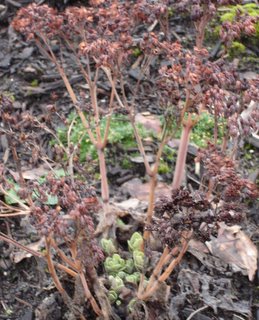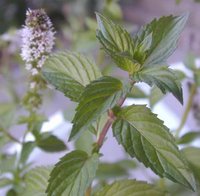 The rain let up this morning, to allow a walk about the soggy yard, and some more clean up in the garden beds. It is encouraging to see new growth, such as the Sedum Spectabile "Brilliant" pictured on right, popping up below the spent blooms. With the arrival of wetter and milder weather, it seems a good time to cut down the remaining spent blooms and dried up (or rather, soggy & brown) stalks from last year's growth. During cold weather, the old growth serves as a buffer or protection for the new buds. Or, for anxious gardeners such as I, as a marker for where the perennials are located. During milder weather, it serves to harbour slugs and other pests, and is best removed.
The rain let up this morning, to allow a walk about the soggy yard, and some more clean up in the garden beds. It is encouraging to see new growth, such as the Sedum Spectabile "Brilliant" pictured on right, popping up below the spent blooms. With the arrival of wetter and milder weather, it seems a good time to cut down the remaining spent blooms and dried up (or rather, soggy & brown) stalks from last year's growth. During cold weather, the old growth serves as a buffer or protection for the new buds. Or, for anxious gardeners such as I, as a marker for where the perennials are located. During milder weather, it serves to harbour slugs and other pests, and is best removed.I also discovered that I have a patch of mint establishing itself within my monarda didyma (bee balm) patch. I remember last year, the single stray stalk of mint, which was growing so close to my monarda, that it would have required digging up both to separate them. Now I may be uprooting a beautiful patch of monarda (it has spread to a lovely 2' wide mat of green) to remove the mint, which has spread by underground runners throughout the patch, and beyond.
Mint is a wonderful plant, and can be picked fresh most of the year to be used as a herbal tea (or infused into tea or hot chocolate), as a garnish, or in a variety of recipes. The dried leaves are great for mid-winter teas. The mint plant forms a wonderful patch of green, with fuzzy bee-attracting flower heads late in the summer. However, it is aggressive and should be planted with care. It would be best suited to a large container (e.g. half barrel) or planted in the "tea garden" (more on that in a later post, but the idea is a somewhat wild area, which is used primarily for harvesting and where spreading and invasive plants can enjoy some room to do what they do best).
In my first herb garden, I planted 5 varieties of mint. The following Spring I discovered what the word invasive means, and relocated it to a patch on a hillside which was bounded by a gravel parking area on one side, and an established lawn on the other. For the next five years, I continued to pull mint out of the garden (where it was originally planted), and relocate it to that patch!
 My favourite mints include Chocolate Mint (Mentha xpiperata 'Chocolate Mint'), a type of peppermint with dark red-brown stalks, and smooth dark green leaves, and a purple flower (photo left). The scent is suggestive of a mint chocolate wafer. The English Mint (Mentha spicata 'English Mint') is
My favourite mints include Chocolate Mint (Mentha xpiperata 'Chocolate Mint'), a type of peppermint with dark red-brown stalks, and smooth dark green leaves, and a purple flower (photo left). The scent is suggestive of a mint chocolate wafer. The English Mint (Mentha spicata 'English Mint') is a variety of spearmint with rich green and smooth (not hairy) leaves, and a wonderful fragrance. The Pineapple Mint (Mentha suaveolens 'Variegata') is a beautiful variegated form of Apple Mint, with a scent suggestive of ripe pineapples (photo right). It is not as vigorous as the other varieties, and may be crowded out in a mixed mint patch.
a variety of spearmint with rich green and smooth (not hairy) leaves, and a wonderful fragrance. The Pineapple Mint (Mentha suaveolens 'Variegata') is a beautiful variegated form of Apple Mint, with a scent suggestive of ripe pineapples (photo right). It is not as vigorous as the other varieties, and may be crowded out in a mixed mint patch.There are many other wonderfully and exotically scented mints, including Apple Mint, Orange Mint, Lemon Mint, Grapefruit Mint, and Lavender Mint. Hairy or non-hairy leaves. Peppermints or spearmints. A wonderful addition to a container garden or "tea garden", just don't let it loose into the garden!


No comments:
Post a Comment